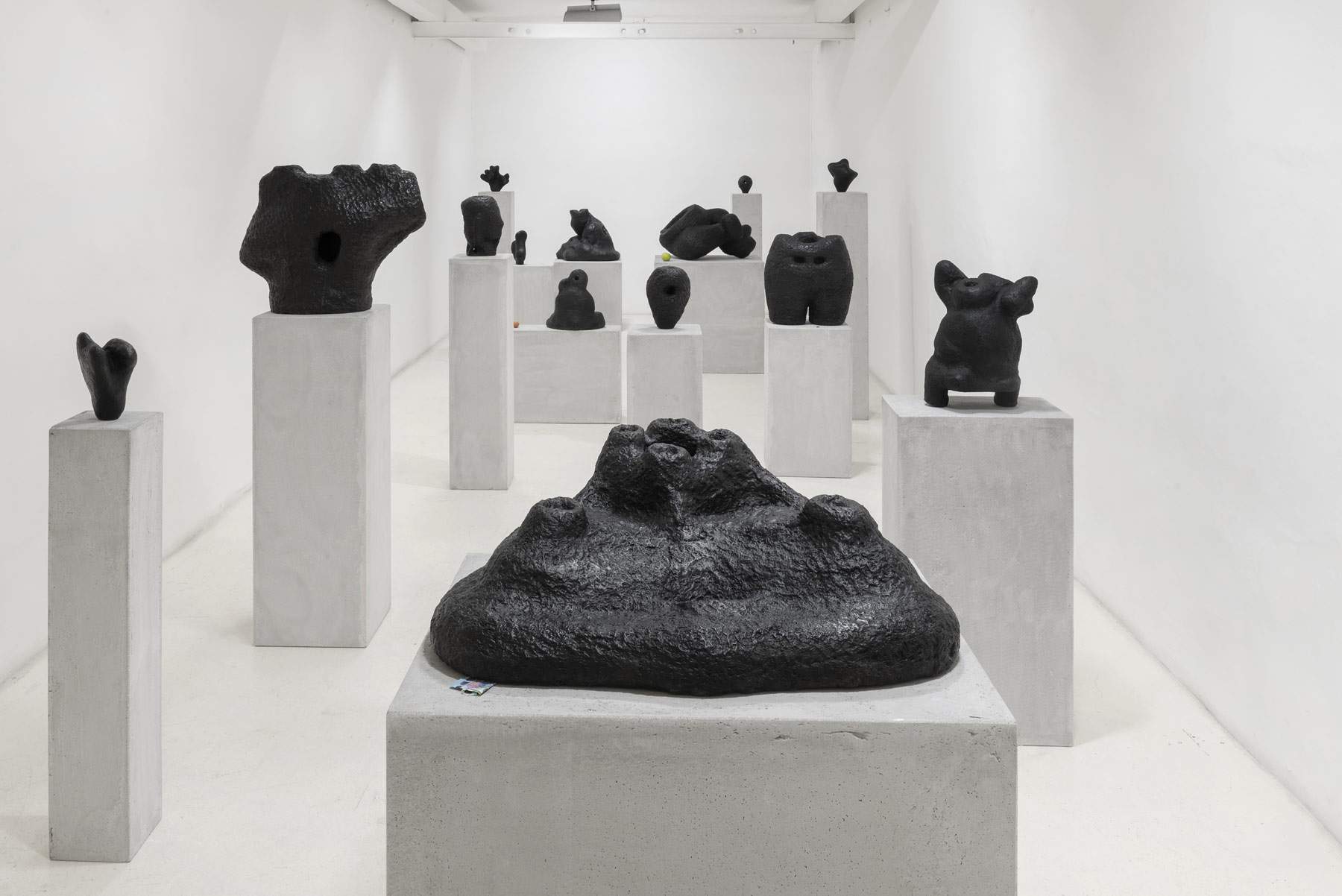From September 23 to November 30, 2020, the Fondazione Pastificio Cerere in Rome is hosting the exhibition Mvaḥ ChÄ, a solo show by Namsal Siedlecki (Greenfield, 1986), curated by Marcello Smarrelli. The event presents for the first time in Italy the results of the Crisalidi project, shown as a preview in January at the Patan Museum (Kathmandu, Nepal): the works were created thanks to the support of the Italian Council (sixth edition, 2019), the program for the promotion of Italian contemporary art in the world of the General Directorate for Contemporary Creativity of the Ministry of Cultural Heritage and Activities and Tourism.
The main core of the exhibition consists of five large bronze sculptures, titled Mvaḥ ChÄ (“Chrysalides”), made by Siedlecki in 2019 during several periods of residence in Kathmandu, where he had the opportunity to experiment and deepen the technique of Nepalese lost-wax casting in some of the most important local foundries, dedicated to the production of sacred sculptures. In particular, the artist was fascinated by the steps that precede the casting: while in the West the wax model is covered with crushed brick and plaster, in Nepal they use a compound called “Mvaḥ ChÄ,” a mortar that is made by mixing clay, cow dung, and chaff, i.e., the husk of rice grains. The title of the sculptures thus comes from the daily practice of the workshops, from that moment when the wax model is covered with layers of “Mvaḥ ChÄ,” forming an envelope so thick that it hides the original form. By choosing such forms, Siedlecki elected these intermediate artifacts, which, though necessary for the making of the sculptures, would never become so since they were usually destroyed to complete the casting process, to become works.
The result of this unusual process are a set of sculptures with indeterminate masses, of the “unfinished,” forms endowed with a strong and primitive expressiveness, free from proportional canons and precise anatomical references, which nevertheless retain a subtle relationship to Hindu and Buddhist religious iconography, while at the same time recalling the archaicist aesthetics of early 20th-century sculpture. Reinforcing the sense of spirituality that pervades the exhibition is the presence of objects such as sweets, money, flowers, eggs, and spirits, the traditional offerings that worshippers in Nepal dedicate to the worshipped deities to avoid their wrath. Siedlecki reactivates that ritual in the exhibition, creating a relationship between Nepalese millenarian culture and the language of contemporary art.
“The scientific and anthropological interest in phenomena, the almost alchemical approach to matter and its state transitions, the attention to different styles and techniques, and the reflection on the value of the work,” says Marcello Smarrelli, curator of the exhibition and Artistic Director of Fondazione Pastificio Cerere, “are the reasons that guided the choice of the artist and the project, with which Fondazione Pastificio Cerere participated in the Italian Council call.”
Once the exhibition is over, the works will become part of the collection of the Luigi Pecci Center for Contemporary Art in Prato, as envisaged by the Italian Council call, which also aims to increase public collections with new productions. “I am very happy that Namsal Siedlecki’s works will enter our collection thanks to the Italian Council,” says Cristiana Perrella, director of the Pecci Center. "Chrysalis manifests not only a rare sensitivity in reflecting on the material, techniques, and processes of sculpture, but also an interest in confrontation with traditions and artistic practices of other cultures that makes these works very representative of our idea of a museum: open to the interaction between different languages of creativity, able to welcome different voices, cultures and points of view and put them in dialogue."
Numerous activities aimed at telling national and international stories about the project: some artist talks were held at the Italian Cultural Institute in London, at the Kronika - Centre for Contemporary Art in Bytom in Poland, and at In extenso, in Clermont-Ferrand in France; artist lectures are planned in the coming months at the Academies of Fine Arts in Rome, Florence and Carrara, the latter in collaboration with the mudaC | museo delle arti di Carrara; in addition, a workshop was held with students from the Liceo Artistico Caravaggio in Rome as part of Collezione Di Classe, the Fondazione Pastificio Cerere project that promotes education in schools through contemporary art. A book on the project, published by Nero, will be presented in November 2020, with texts by Marcello Smarrelli, Artistic Director Fondazione Pastificio Cerere, Sangeeta Thapa, Director Siddhartha Arts Foundation, Charles Jamyang Oliphant of Rossie, Ph. D University of Oxford, Department of Oriental Studies.
Namsal Siedlecki, from the United States, lives and works in Seggiano (Grosseto, Italy). In 2015 he won the fourth edition of the Moroso Prize and the Cy Twombly Italian Affiliated Fellow in Visual Arts at the American Academy in Rome; in 2019 he won the Club Gamec Prize and the Cairo Prize. In recent years he has exhibited his work at numerous national and international institutions including: In extenso, Clermont-Ferrand; MAXXI, Rome; Villa Medici, Rome; Centro per l’Arte Contemporanea Luigi Pecci, Prato; Galeria Boavista, Lisbon; Villa Romana, Florence; Fondazione Sandretto Re Rebaudengo, Turin; 6 Moscow International Biennale for Young Art, Moscow; Chertludde, Berlin; Magazzino, Rome; American Academy in Rome; Museo Apparente, Naples; Fondazione Pastificio Cerere, Rome; Fondazione Bevilacqua La Masa, Venice; Antinori Art Project, Bargino; Galeria Madragoa, Lisbon; Frankfurt am Main, Berlin; Cripta747, Turin. From 2008 to 2013 he managed the independent space GUM studio, first in Carrara and then in Turin.
 |
| Rome, Namsal Siedlecki bridges Nepalese culture and Western art at his new solo exhibition |
Warning: the translation into English of the original Italian article was created using automatic tools. We undertake to review all articles, but we do not guarantee the total absence of inaccuracies in the translation due to the program. You can find the original by clicking on the ITA button. If you find any mistake,please contact us.